The American Board of Plastic Surgery has changed a lot since I began training as a Plastic Surgeon. Originally, Plastic Surgeons had to pass a written and oral examination and then they were Board Certified. This meant they completed a qualified residency in Plastic Surgery and met the criteria required by the Board. There was a fee for these exams, but then no further fees were collected.
Maintenance of Board Certification
This changed in 1996, when the era of Maintenance of Certification began. In addition to the initial written and oral examinations, another written exam was required every ten years. The goal was to ascertain that Board Certified Plastic Surgeons were still at the top of their game. Of course, with this came new fees. Yearly fees were instituted and additional fees for the exams and specifically required CME.
Continuous Board Certification
Currently, the American Board of Plastic Surgery has shifted to Continuous Certification. Exams are now required every year and the yearly fees have only increased. For busy plastic surgeons, I’m not convinced that these exams make me a better plastic surgeon. I pass every year, but my learning is continuous and will continue to be regardless of how many exams are required. Maybe next year the exams will be monthly.
You can check my or any other Plastic Surgeon’s Board Certification on the American Board of Plastic Surgery Website.
The Mission of the American Board of Plastic Surgery
“The Mission of the American Board of Plastic Surgery Inc., is to promote safe, ethical, efficacious plastic surgery to the public by maintaining high standards for the education, examination, certification and continuous certification of plastic surgeons as specialists and subspecialists.”
Directors of The American Board of Plastic Surgery are actively engaged in the practice of plastic surgery. Importantly, unlike other medical boards, these members volunteer to serve without remuneration.
My ABPS Continuous Certification
I received my first Board Certification in 1999, so every year there has been an ever increasing list of requirements. The latest examination results have been certified, and below is a copy of my letter of approval.

Above is a copy of my continuous certification approval letter. Another year, another perfect result.
More details on my initial certification and recertification can be found in this previous post entitled: Board Certified by the American Board of Plastic Surgery.
Other Board Certifications
Some Cosmetic Surgeons have other certifications. Most of the time, these are in addition to the ABPS Certification. More worrisome however, is when these are instead of ABPS Certification.

The American Board of Surgery also requires recertification.
In my case, I am Double Board Certified. This means I am certified by both the ABPS and the American Board of Surgery. Before my three year fellowship in Plastic Surgery, I completed a full residency in General Surgery, including a chief resident year. This makes me eligible for Board Certification by the American Board of Surgery (ABS). I obtained my Surgery Boards in 1995, and have recertified three times. Beginning in August of 2025, I am required to move to continuous certification for this board as well.
Other Board Certifications
There is a lot of overlap between Plastic Surgery and other specialties. In 1937, the American Board of Plastic Surgery was formed primarily by General Surgeons and Otolaryngologists (Ear Nose of Throat Surgeons) who specialized in plastic and reconstructive surgery. Plastic Surgeons have pioneered reconstructive surgery such as breast reconstruction, hand surgery, wound care, burn reconstruction and the treatment of congenital anomalies, and cosmetic surgery, which has increased in acceptance over the last thirty years.
Most specialties are divided anatomically; however, plastic surgery, like general surgery, treats the entire body, and has no specific anatomic home. Other specialty boards are limited to specific areas of the body, for example the American Board of Ophthalmology treats the eyes and their supporting structures. The American Board of Otolaryngology covers the ears, nose and throat. There are very good specialists with training in these areas who do both reconstructive and cosmetic surgery very well.
Not All “Boards” Are Created Equal
Anyone can start a board, and the board titles can be confusing, if not misleading. The Boards mentioned above are all official American Board of Medical Specialties (ABMS) recognized specialty boards. The ABMS recognition is the “gold standard” of professional medical boards. Online, the ABMS lists the Member Boards.
The American Board of Cosmetic Surgery sounds perfect, but it is not an ABMS recognized board, and its members tend to have the least amount of training. In fact, the American Board of Cosmetic Surgery only requires one year training; moreover, it may be the only year of surgical training received. Sadly, this is fewer than any of the “real” ABMS boards listed above.
In California, the Medical Board of California (MBC) has deemed the American Board of Cosmetic Surgery (ABCS) certification as not equivalent to the standards of the American Board of Medical Specialties (ABMS) boards, such as the American Board of Plastic Surgery. This means that ABCS diplomates in California cannot legally advertise themselves as “board-certified” in cosmetic surgery. The MBC found that ABCS training programs do not meet the state’s requirements for scope, content, and duration compared to those accredited by the Accreditation Council for Graduate Medical Education (ACGME).
Less is not More
Some people believe that limiting the number of operations they perform makes them better at it. I do not agree. It makes as much sense as saying a jazz musician cannot play rock. A good musician can cover many styles of music, because they are good with their instrument(s).
Skin tightening surgeries (facelifts, arm lifts, breast lifts, tummy tucks, or thigh lifts) all require the use of the same instruments, surgical principals and must follow anatomical rules, so there is a lot of cross-over knowledge. In addition, there is an advantage to having a doctor-patient relationship with a surgeon who is well versed in multiple surgeries and techniques should you desire more than one operation. Consider also that Plastic Surgeons dedicated their training to do Plastic Surgery before starting their training, not as an afterthought.
Board Certification Matters

The logo above may only be used by surgeons certified by the American Board of Plastic Surgery.
Your results will depend on the training and experience of your surgeon. If your surgeon is well trained, and has sufficient experience, then the chances of a good result are enhanced. Board Certification is one way to check on your chosen surgeons training. It is not the only way, but it might be the easiest way. You should check your surgeon’s board certifications and state medical license status on-line. It’s quick and it’s easy. Here are some handy links:
- The American Board of Plastic Surgery – Check Certification Here
- The American Board of Surgery – Check Certification Here
- California Medical Board – Check License Here
Cosmetic Plastic Surgery Consultations
In the San Francisco Bay Area call (925) 943-6353 to schedule a private consultation appointment in our Walnut Creek Plastic Surgery office. For a list of the procedures we offer and before and after pictures search this blog by category or visit our main website at DrMele.com.
Previous Post Next Post